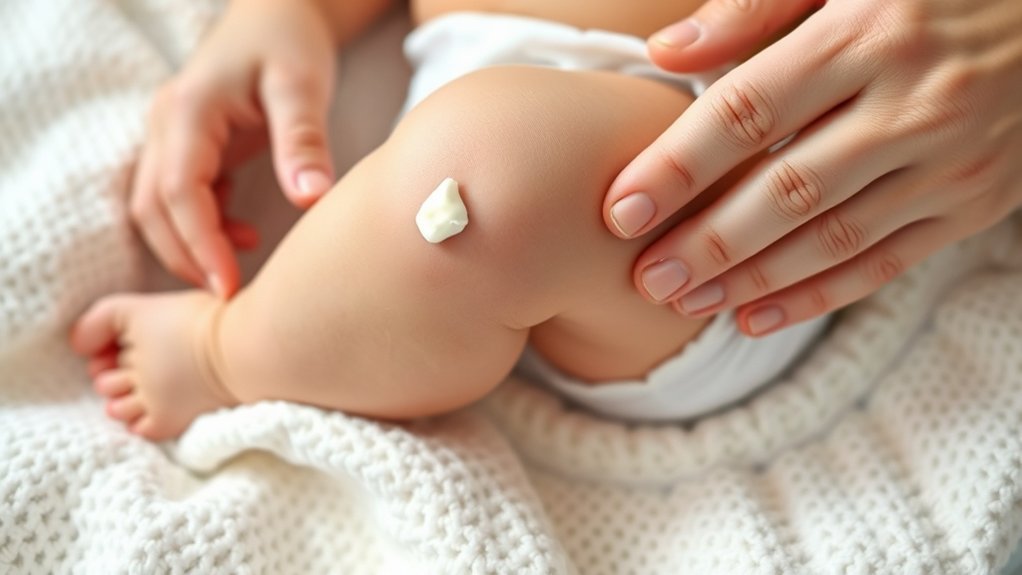When your baby develops a red, irritated bottom, it can be concerning for any parent. Diaper rash is common, but knowing when to seek medical help is crucial. If the rash doesn’t improve within three days or seems to worsen, it may be time to consult a doctor. Understanding the signs of a more serious issue can help protect your baby’s health. Let’s explore the key indicators that should prompt a visit to your healthcare professional.
Understanding Diaper Rash: Causes and Symptoms
Diaper rash is a common condition that can cause discomfort for your baby, often resulting from prolonged exposure to moisture, friction, or irritants in the diaper area.
Understanding diaper rash causes is essential for prevention and timely treatment. Factors such as infrequent diaper changes, diarrhea, or the use of certain soaps can contribute to the problem.
You’ll notice diaper rash symptoms like redness, swelling, or small bumps on your baby’s skin, often accompanied by tenderness or fussiness during diaper changes.
Addressing these symptoms quickly can help soothe your baby and restore their comfort.
Common Over-the-Counter Treatments for Diaper Rash
When diaper rash occurs, addressing it promptly with the right treatments can make a significant difference in your baby’s comfort.
Over-the-counter diaper creams often provide effective relief, allowing your little one to feel better quickly. Here are some common options you might consider:
Over-the-counter diaper creams can quickly soothe diaper rash, helping your baby feel more comfortable.
- Zinc oxide creams: These create a protective barrier on the skin, helping to soothe irritation.
- Petroleum jelly: A natural remedy that acts as a moisture barrier, preventing further rash development.
- Aloe vera gel: Known for its soothing properties, this can help calm inflamed skin.
Choosing the right diaper cream and incorporating natural remedies can empower you to manage diaper rash effectively, ensuring your baby’s skin stays healthy and comfortable.
When to Seek Medical Attention for Diaper Rash
How can you tell if your baby’s diaper rash needs more than just home treatment? If the rash persists despite your efforts or worsens, it’s time to reflect on a medical consultation.
Pay attention to diaper rash triggers, such as dietary changes or new products, which can indicate underlying issues. If your baby develops blisters, open sores, or signs of infection like fever or pus, seeking help is vital.
Remember, you know your baby best—trust your instincts. It’s okay to ask for guidance if you’re unsure. Early intervention can prevent complications and provide peace of mind.
Prioritizing your baby’s comfort and health is essential, so don’t hesitate to consult a healthcare professional for persistent or troubling symptoms.
Signs of Severe Diaper Rash That Require Immediate Care
Recognizing the signs of severe diaper rash can be essential for your baby’s comfort and health. If you notice any of the following symptoms, it’s vital to seek immediate medical attention:
- Severe irritation: Skin appears bright red, swollen, or cracked.
- Infection signs: Watch for pus-filled blisters, swelling, or fever.
- Persistent rash: The rash worsens despite treatment or lasts longer than three days.
These indicators may signify that your baby requires specialized care to prevent further complications.
Don’t hesitate to consult a healthcare professional if you’re concerned. Your baby’s well-being is paramount, and timely intervention can provide relief from pain and discomfort, ensuring a happier, healthier experience for both of you.
Preventive Measures to Reduce the Risk of Diaper Rash
To effectively reduce the risk of diaper rash, maintaining proper hygiene and skin care is essential.
Change your baby’s diaper frequently, ideally every two to three hours, to minimize moisture exposure.
When you change diapers, gently cleanse the area with mild soap and water or natural remedies like coconut oil or aloe vera.
Allow the skin to air dry before applying a new diaper.
Opt for breathable materials to enhance diaper hygiene and prevent irritation.
Additionally, consider using a barrier cream with zinc oxide to protect the skin.
When you follow these preventive measures, you’ll create a healthier environment for your baby’s skin, ultimately promoting comfort and reducing the likelihood of diaper rash.
Frequently Asked Questions
Can Diaper Rash Be Caused by Food Allergies?
Yes, food allergies can contribute to diaper rash. If you notice a rash coinciding with new foods, it’s essential to observe any patterns and consult your pediatrician for guidance on managing symptoms effectively.
How Can I Soothe My Baby’s Discomfort From Diaper Rash?
To soothe your baby’s discomfort from diaper rash, try gentle cleansing, applying a barrier cream, and allowing diaper-free time. Incorporating these soothing techniques also aids in rash prevention, promoting healthier skin for your little one.
Are Natural Remedies Effective for Treating Diaper Rash?
Natural treatments can provide gentle relief for diaper rash, but their effectiveness varies. It’s crucial to evaluate each remedy’s impact on your baby, ensuring comfort while fostering a healing environment for delicate skin.
Can Diaper Rash Occur in Older Children or Adults?
Yes, diaper rash can occur in older children and adults. It’s often caused by moisture, friction, or irritants on sensitive adult skin. Prompt attention can help prevent further discomfort and promote healing.
How Often Should I Change My Baby’s Diaper to Prevent Rash?
You should change your baby’s diaper every two to three hours, or immediately after a bowel movement. Frequent diaper changing is essential for rash prevention, keeping your baby comfortable and their skin healthy.
Conclusion
Diaper rash can be a frustrating experience for both you and your baby, turning joyful moments into uncomfortable ones. Yet, with the right knowledge and treatment, you can navigate this challenge effectively. Remember, if the rash lingers or worsens, don’t hesitate to seek medical help. Your baby’s comfort is paramount, and addressing concerns early can make all the difference. Stay vigilant, and you’ll guarantee those little smiles shine through, even during diaper changes.
